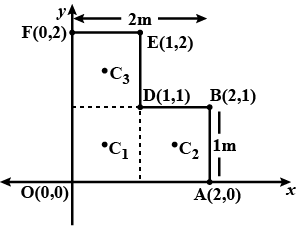
Find the center of mass of a uniform L shaped lamina (a thin flat plate) with dimensions as shown. The mass of the lamina is 3 Kg.

(A) 5/6 m, 5/6 m
(A) 3/4 m, 3/4 m
(A) 5/8 m, 5/8 m
(A) 3/5 m, 3/5 m

Answer
510.6k+ views
Hint
The center of mass is a position defined relative to an object or system of objects. It is the average position of all the parts of the system, weighted according to their masses. ... Sometimes the center of mass doesn't fall anywhere on the object.
Complete step by step answer
Choosing the X and Y axes. We have the coordinates of the vertices of the L. shaped lamina as given in the figure. We can think of the L-shape to be constant of 3 squares each of length 1m. The mass of each square is 1 Kg. Since the lamina is uniform.
The center of mass of each square in X,Y coordinate $C_1 \,(1/2,1/2) $,$C_2 \,(3/2,1/2) $ and $C_3 \,(1/2,3/2) $ of the square are by,
Formula for center of mass,
$\Rightarrow X = \dfrac{{{m_a}{x_a} + {m_b}{x_b} + {m_c}{x_c}}}{{{m_a} + {m_b} + {m_c}}} $ ...(1)
And, $Y = \dfrac{{{m_a}{y_a} + {m_b}{y_b} + {m_c}{y_c}}}{{{m_a} + {m_b} + {m_c}}} $ ....(2)
Now put the values in the equation 1 and 2 we get,
$\Rightarrow X = \dfrac{{[1(1/2) + 1(3/2) + 1(1/2)]}}{{(1 + 1 + 1)}} = \dfrac{5}{6} $ m
Now continuing the equation 2
$\Rightarrow Y = \dfrac{{[1(1/2) + 1(1/2) + 1(3/2)]}}{{(1 + 1 + 1)}} = \dfrac{5}{6} $ m
So, the center of mass for the L shape is $\left( {\dfrac{5}{6},\dfrac{5}{6}} \right) $.
Option (A) is correct.
Note
The velocity of the system's center of mass does not change, as long as the system is closed. The system moves as if all the mass is concentrated at a single point. The final location will be at the weighted distance between the masses.
The center of mass is a position defined relative to an object or system of objects. It is the average position of all the parts of the system, weighted according to their masses. ... Sometimes the center of mass doesn't fall anywhere on the object.
Complete step by step answer
Choosing the X and Y axes. We have the coordinates of the vertices of the L. shaped lamina as given in the figure. We can think of the L-shape to be constant of 3 squares each of length 1m. The mass of each square is 1 Kg. Since the lamina is uniform.
The center of mass of each square in X,Y coordinate $C_1 \,(1/2,1/2) $,$C_2 \,(3/2,1/2) $ and $C_3 \,(1/2,3/2) $ of the square are by,
Formula for center of mass,
$\Rightarrow X = \dfrac{{{m_a}{x_a} + {m_b}{x_b} + {m_c}{x_c}}}{{{m_a} + {m_b} + {m_c}}} $ ...(1)
And, $Y = \dfrac{{{m_a}{y_a} + {m_b}{y_b} + {m_c}{y_c}}}{{{m_a} + {m_b} + {m_c}}} $ ....(2)
Now put the values in the equation 1 and 2 we get,
$\Rightarrow X = \dfrac{{[1(1/2) + 1(3/2) + 1(1/2)]}}{{(1 + 1 + 1)}} = \dfrac{5}{6} $ m
Now continuing the equation 2
$\Rightarrow Y = \dfrac{{[1(1/2) + 1(1/2) + 1(3/2)]}}{{(1 + 1 + 1)}} = \dfrac{5}{6} $ m
So, the center of mass for the L shape is $\left( {\dfrac{5}{6},\dfrac{5}{6}} \right) $.
Option (A) is correct.
Note
The velocity of the system's center of mass does not change, as long as the system is closed. The system moves as if all the mass is concentrated at a single point. The final location will be at the weighted distance between the masses.
Recently Updated Pages
Master Class 11 Social Science: Engaging Questions & Answers for Success

Master Class 11 Physics: Engaging Questions & Answers for Success

Master Class 11 Maths: Engaging Questions & Answers for Success

Master Class 11 Economics: Engaging Questions & Answers for Success

Master Class 11 Computer Science: Engaging Questions & Answers for Success

Master Class 11 Chemistry: Engaging Questions & Answers for Success

Trending doubts
What is meant by exothermic and endothermic reactions class 11 chemistry CBSE

10 examples of friction in our daily life

Difference Between Prokaryotic Cells and Eukaryotic Cells

1 Quintal is equal to a 110 kg b 10 kg c 100kg d 1000 class 11 physics CBSE

One Metric ton is equal to kg A 10000 B 1000 C 100 class 11 physics CBSE

Draw a diagram of nephron and explain its structur class 11 biology CBSE




